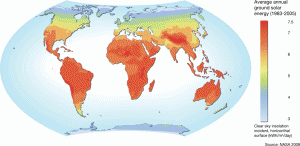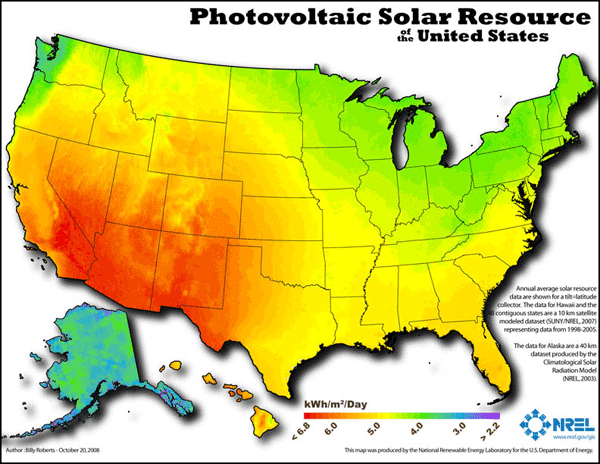Solar Energy Is Everywhere the Sun Shines
Solar energy is the Earth’s most available source of energy. Solar energy generation is able of providing many times our current energy demand. However, it is a sporadic source of energy, meaning that the amount of energy you would get would be the same all the time. However, it can be supplemented by energy storage or using other energy sources.
Here is a solar resource map of both the United States and the World. This map indicated where how much solar energy you will receive by location.
[maps]

Source: United Nations Environment Programme (UNEP), NASA Surface meteorology and Solar Energy (SSE), 2008.
California Has the World’s Biggest Solar Concentrating Power Plant
There are 9 solar power plants, in different locations in California’s deserts. These plants comprise the Solar Energy Generating Systems (SEGS). SEGS plants are concentrating solar thermal plants. They are the largest solar power generating plants in the world, generating up to 354 MW.
Concentrating solar power technology uses mirrors to concentrate and reflect sunlight onto receivers that collect the energy of the sunlight and convert it to heat. This heat can then be used to produce electricity by using a steam turbine or heat engine driving a generator.
Europe Has Some Large Photovoltaic Power Plants
Another solar generating technology uses photovoltaic cells (PV) to convert sunlight directly into electricity. These are more commonly called ‘solar panels.’ PV cells are made of semiconductors, such as crystalline silicon or various thin-film materials. Photovoltaics can provide tiny amounts of power for watches, large amounts for the electric grid, and everything in between.
The Moura photovoltaic power station in Portugal and the Waldpolenz Solar Park in Germany, both completed phase 1 in 2008, represent the trend toward larger photovoltaic power stations.
Other Uses of Solar Power
Low-temperature solar collectors also absorb the sun’s energy in the form of heat, but instead of making electricity, use the heat for hot water or space heating for your home or building.

Leave a Reply